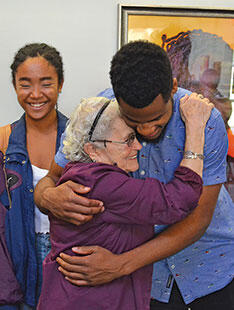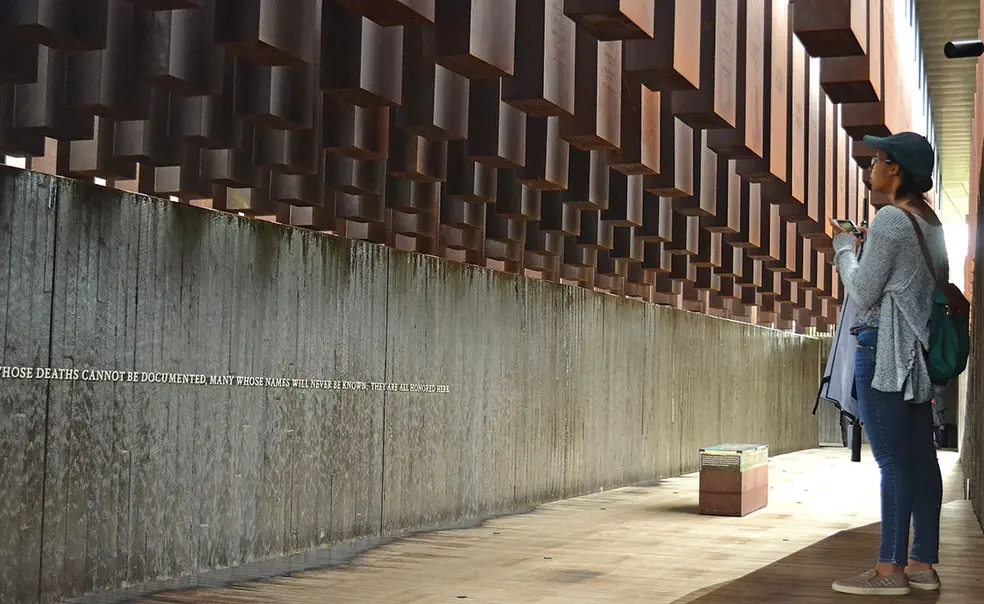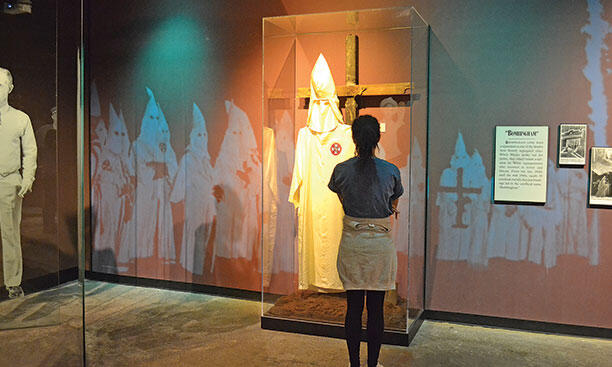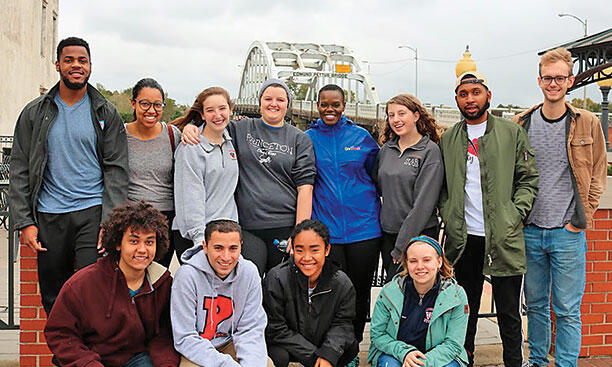Race and Redemption
On a fall-break trip to Alabama, students confront our civil-rights history
We shall overcome, we shall overcome
We shall overcome, some day
Oh, deep in my heart, I do believe
We shall overcome, some day
Thirteen Princeton students and staff members joined hands to sing “We Shall Overcome” inside a small building on the outskirts of Alabama State University in Montgomery, Ala., dedicated to the history of the civil-rights movement and African American culture. ASU professor Dorothy Autrey, who led the singing, described the role that songs played in the 1955–56 Montgomery bus boycott sparked by Rosa Parks and in other events in the civil-rights movement that took place nearby.
“They sang when they marched at demonstrations to keep time, and they sang in jail — sometimes they literally sang all night long and drove the jailers crazy,” Autrey said. “And most of them were young people just like you are.”
The visit was one of several stops on the five-day Race and Redemption Tour, a fall-break trip sponsored by Princeton’s Office of Religious Life. Eleven students — 10 from the University and one from Princeton Theological Seminary — traveled to civil-rights monuments, museums, and memorials across Alabama to trace the history of discrimination in the American South, beginning with the trans-Atlantic slave trade, Jim Crow, and the activism of the civil-rights movement, and through issues of mass incarceration and voter suppression that are still present today.
Students said one of the most striking moments of the trip was a visit to the National Memorial for Peace and Justice, which commemorates victims of lynching in the United States. More than 800 hanging steel rectangles — the size and shape of coffins — represent each county where a lynching took place. The outdoor memorial hit close to home for students: One rectangle acknowledged an 1886 lynching in Monmouth County, N.J., 40 miles from Princeton, and Amanda Eisenhour ’21 learned the names of two men who were lynched in her hometown of Alexandria, Va.
“This trip forced me to go through the process of what the civil-rights movement was and what a big organizing effort it was, instead of just looking at the results. It has really impacted me and will probably change how I organize in the future,” said Eisenhour, who is active in Students for Prison Education and Reform (SPEAR), a student group.
Other stops on the trip included the Tuskegee Airmen National Historic Site, the Birmingham Civil Rights Institute, the 16th Street Baptist Church and Chabad of Alabama in Birmingham, and the Edmund Pettus Bridge in Selma.

A highlight for many students was the Southern Poverty Law Center (SPLC) in Montgomery, where they spoke with former SPEAR activist Daniel Teehan ’17, who is working to improve mental-health and medical care in Alabama prisons. Some inmates do not have a psychiatrist to write prescriptions, he told the group, and some in mental-health units don’t leave their cells for more than two hours each day.
“This trip has made me so sure about what I want to do, which is to go into civil-rights legal work,” said Masha Miura ’21. “Especially after speaking with Daniel and the others at SPLC — [they are] doing exactly the kind of work that I’ve always wanted to do.”
Students met with activists who had protested conditions in the South decades ago and still live in Alabama, including Jean Graetz, whose husband helped organize the Montgomery bus boycott and whose home was bombed by the Ku Klux Klan; Valda Harris Montgomery, whose family housed Freedom Riders on their way through Montgomery; and Sam Walker, who was put in jail as a 12-year-old boy for protesting laws that disenfranchised black citizens. Walker is now the historian at the National Voting Rights Museum in Selma.
“It was empowering to see that so many people were involved,” said Noam Miller ’21. “For every big march there were smaller marches and smaller players involved — it gave me a little hope because I often get down about what I can actually contribute.”
Theresa S. Thames, associate dean of religious life and the Chapel at Princeton and the trip’s organizer, said she hoped students would take away the importance of activism and the role of college students in the civil-rights movement and examine differences and similarities between issues of social justice and race in the 1950s and ’60s and today.
“Students know of the civil-rights movement and a few key leaders,” Thames said. “However, they are grossly undereducated and miseducated on the many aspects of slavery, Reconstruction, and Jim Crow in America. Also, students believe that these events are ancient history instead of only 50 to 60 years ago.”
Despite the abundance of devastating and dark stories that they encountered during the week, the students left Alabama feeling hopeful about the progress that has been made over the past 50 years and inspired to think about how they could become more involved in campus activism. Some questioned the ways that Princeton and other institutions in the North have recognized their own histories of racism.
“In my opinion, Princeton needs to do a better job of grappling with its history relating to slavery and use that understanding to reach out to underprivileged communities like Trenton,” said Miura. “Looking back on this trip, I really appreciated the fact that even though the monuments we visited in the South may have not been perfect, at least they were there. That was a very important lesson for me.”














3 Responses
Walter Weber ’81
6 Years AgoLearning History
Educational excursions like the fall-break trip to Alabama to address civil-rights history can be immensely valuable to students. History is something to learn, not hide, even when it is unpleasant.
Princeton has recently confronted both its own complicity with slavery and the racism of Woodrow Wilson 1879. I hope the Alabama trip likewise exposed the participants to the uncomfortable fact that it was the Democratic Party that fought for slavery and segregation; opposed the constitutional amendments giving blacks freedom, citizenship, and the right to vote; and opposed the civil-rights bills of the middle of the 20th century. I mention this because the faculty and student body at Princeton reportedly tilt lopsidedly Democratic. All the more reason not to hide the skeletons in the Democratic closet.
I also hope someone pointed out that the Southern Poverty Law Center, visited on this student trip and reported in the article as a “highlight for many students,” has been convincingly charged with being a scam operation by articles in numerous media outlets, including Philanthropy magazine, The Washington Post, The Weekly Standard, and National Review.
Kabir Mahadeva ’81
6 Years AgoSkeletons in the Closet
My classmate Walter Weber ’81 (Inbox, Jan. 9) is senior counsel for the American Council of Law and Justice (ACLJ), an extreme-right organization founded by Pat Robertson. Jay Sekulow, one of President Trump’s legal advisers, is chief counsel for the ACLJ. Mr. Sekulow has amassed great wealth in connection with the ACLJ and its related charities as reported in The Washington Post and The Guardian.
One could argue that it, too, is a “scam organization.” While casting stones at the Democrats, Mr. Weber conveniently omits that the Civil Rights Act of 1964 was championed by a Democrat, President Lyndon Johnson.
Mr. Weber is well-known for his opposition to reproductive freedom. The ACLJ has supported anti-LGBT laws and penalizing homosexuality by death in African countries.
Arguing that the Democrats of today are the same as the ones 55 years ago is disingenuous. Almost no one would recognize today’s Republicans as the party of Lincoln, as evidenced by its efforts toward voter suppression and disenfranchisement of poor and minority voters.
On one point, I completely agree with Mr. Weber: The Democratic Party does have its skeletons in the closet, with one corollary: So do the Republicans.
Donald Burnes ’63
6 Years AgoLearning History
I read with great interest “Race and Redemption” (On the Campus, Dec. 5), and I applaud Princeton for creating the opportunity for such a trip. The description of the trip brought back many memories of my time in Alabama.
More than 50 years ago, I participated in the Selma to Montgomery march, joining the marchers as they approached the state capitol building. A year later, I joined the staff and faculty at Miles College, just outside Birmingham, as both a teaching faculty member and the special assistant to the president of this black college. The president, Dr. Lucius Pitts, took great pleasure in introducing me as the “house honky in the administration.”
During my year and a half at Miles, my ex-wife and I had numerous fascinating experiences involving overt and covert racism because of our association with the college. I remember vividly being asked to leave a Sunday-morning church service because a black colleague of mine attended the service with me. I also remember that the real-estate agent who sold our house to us, when he discovered that both of us were working at Miles, said, “I shouldn’t sell you this house, but I like the two of you. Our agency may well go out of business because of this sale, but I’m going to go ahead anyway.” Sure enough, the agency went out of business within a year.
I keep wondering whether my experiences would be of any use to students who take the same trip in the future.